Mikhail Katkoff analyzed in detail the mechanics of Puzzle & Dragons, the highest-grossing game in the world, earning up to $86 million per month in the Japanese market alone.
According to the latest data, the Puzzle & Dragons card battler from GungHo earned from $62 to $86 million in one February. Despite its success in Japan, the game does not show the best results in the Western market.

In this post I will go through 8 mechanics of this game, thanks to which it shot in the Land of the Rising Sun. In my opinion, these 8 mechanics are also the reason why the game does not show much results in the USA.
The core
The key mechanics of Puzzle & Dragons are very simple.
The player enters the dungeon, a certain amount of stamina is spent on it, depending on the complexity of the dungeon. Stamina recovers over time. For completing the dungeon, the player gets experience, coins and a few random monsters.
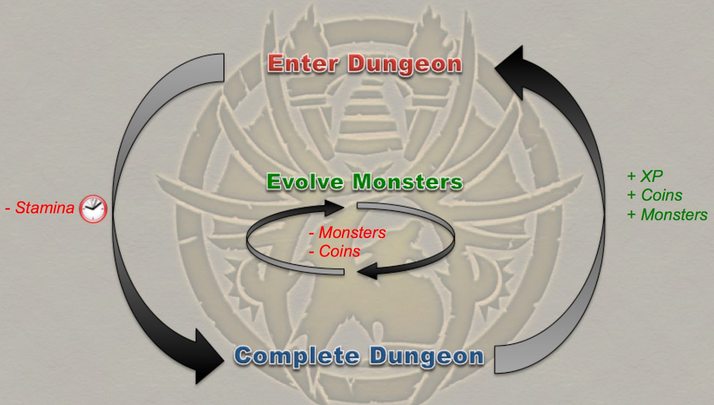
As the dungeons become more and more difficult, the player needs to constantly grow in levels and improve their own monsters. Raising the level of monsters improves their characteristics. When monsters reach the highest level, the player can turn them into other, more powerful monsters (in the game this is called evolution). This requires a special kind of rare monsters and coins. The amount of coins needed to level up or evolve depends, respectively, on the level of the monster and its coolness.
8 key mechanics
1. Simplicity
At first glance, Puzzle & Dragons seems to be a very simple game. In essence, the user only needs to play a simple match-3 and do not forget that only those monsters whose color matches the diamond chains they have collected strike.
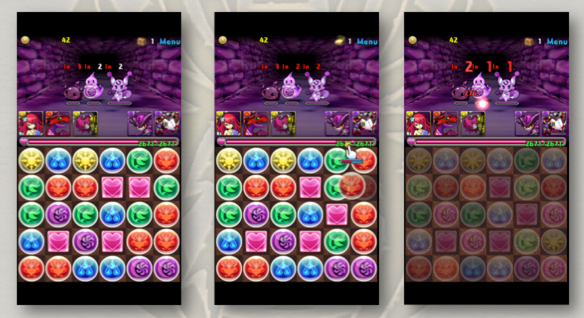
The more crystals collected “in a row”, the higher the damage. Yes, it’s that simple.
After each dungeon, the player is given an egg from which a monster is born. It is impossible to predict what kind of monster will appear.
2. Complexity
After completing a dozen dungeons, two things happen. Firstly, there is not enough space for maps in the monster library, and you have to decide which monster to keep and which to get rid of (to raise the level to sell or sacrifice another monster). Secondly, difficult opponents begin to meet, which require tougher troops to defeat. The demand for more advanced monsters leads players to start thinking about how to get them.
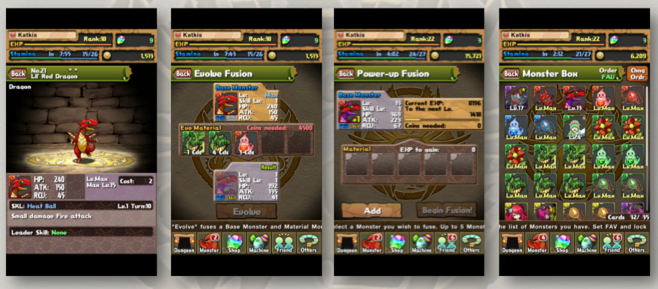
A large number of monsters, their development, decks – all this makes Puzzle & Dragons a challenging game
This complicates the gameplay.
Deck formation is essentially a game within a game. Which monster should I leave behind? Which monster should I get rid of? What should my deck look like? How to ensure the best combination of special skills? Which monster should I find in order for my other monster to evolve into a third one?
It also affects the player’s behavior. The level of engagement is growing because the player is not just enjoying match-3. Now each session has a specific goal, and the player starts playing more often to earn more money, which he will then spend on sacrifices.
3. Stamina
One of the main limitations in Puzzle & Dragons is stamina, which is consumed every time a player enters a dungeon. There are several things that distinguish stamina in the game from the energy more familiar to us from Facebook games.
Stamina mechanics are made in such a way that it allows you to make great progress at the beginning of the game, but with each earned level, the dynamics of growth decreases. The fact is that the stamina consumption of beginners is minimal, and they recover it very quickly. It’s different for advanced players. Stamina is consumed quickly, but grows slowly. It is clear that slowing down progress is one of the best ways to monetize the game.

Each dungeon has its own price for entry
But stamina has two additional advantages in the game. Firstly, different amounts of stamina are spent on entering different dungeons. Increasing the price of entry to more complex dungeons limits the length of an advanced user’s session. Secondly, when you don’t have to worry about an inexperienced player getting into a difficult dungeon (he just doesn’t have so much stamina), you can demonstrate it to everyone. So the newcomers will have a goal.
4. Monster Costs
To improve monsters, the player must raise their level and engage in their evolution.
Raising the level of monsters requires the player to sacrifice other monsters. As soon as the monster reaches the maximum level, the user can turn it into a cooler and rarer creature. But it’s not easy. To do this, the user will need to find a whole set of rare creatures.
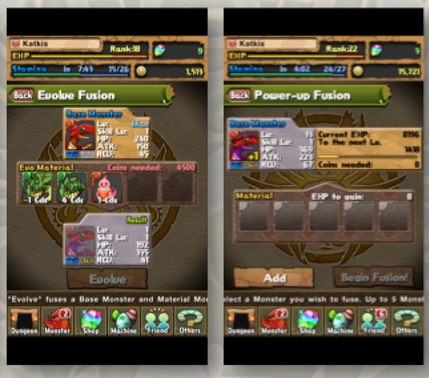
First, to raise the level of the monster, the player must sacrifice his other cards. When a monster reaches the maximum level, the player has to look for special “evolutionary” creatures for further development of cards in his deck.
Coins are also spent on raising levels and on evolution. The only way to earn them is through dungeons. Coins can’t even be bought with real money. So the player in any case has to invest his time in the project.
But the coolest thing about the game is that monsters can be both important figures and just consumables. It all depends on the user. This allows the game economy to constantly reward users with dozens of different monsters.
5. Elements of gambling
In Puzzle & Dragons, the user cannot buy the monsters that he likes or needs. For a trip to the dungeon or from the gaming machine, he always gets a “pig in a poke” – an egg. What kind of monster is in the egg, the player does not know.
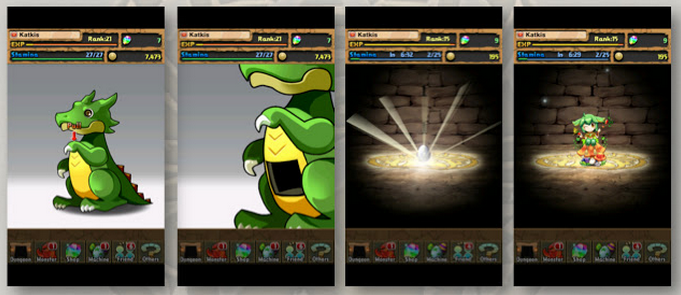
Click on the dragon’s paw, watch as an egg appears from it, from which, in turn, a random monster is born. It looks like a slot machine, only here the player always wins
The absence of direct sales, the randomness of this whole process is the key to success in terms of monetization. So the developers have increased the level of involvement in the project.
Just think! If a player does not have to go through dozens of dungeons just to increase the level of a single monster, he will not feel that he has invested in the game.
The lack of direct sales also works for the gaming economy. The player cannot run through all the dungeons in half an hour, buying the coolest monsters. It also removes any restrictions on the amount spent. The player, instead of spending money on one monster, spends tens of dollars on a slot machine that sells random monsters.
6. Fast content production
All free-to-play games depend on new content that is distributed via updates. A good update contains something new that contributes to the player’s future spending.
But there is a difference between adding new content on a monthly basis or doing it in streaming mode. In the latter case, the team is constantly working on this, trying to save the player from boredom. But if you focus only on producing content, other aspects of the game may suffer. These aspects include stability, graphics, UI, brand, social functions, and so on.
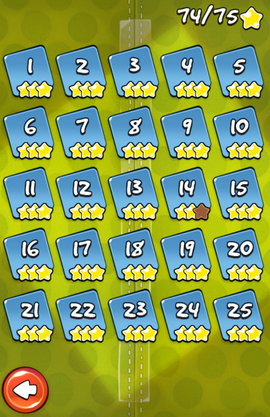
Games with level-based mechanics are one example of “streaming” development. As soon as players complete the game, they leave it until the next update.
In principle, this can be avoided by adding social functions, such as chat, the ability to form alliances or interest groups. So users themselves will, in fact, form the content. PvP is another great way to avoid the “factory”.
But GungHo chose a different path. The fact is that the content in Puzzle & Dragons is very easy to produce. The dungeons are similar to each other and differ only in the color of the walls and the types of enemies: creating a hundred additional dungeons is not a problem. Monsters? A couple of artists who will draw more or less decent static dragons and girls with breast sizes from the third and above are enough.

Fire dungeon, water dungeon, stone dungeon – they all look identical, and therefore they are easy to make
7. Social aspect
I would say Puzzle & Dragons is a social game, but in its own way. There is no chat, no PvP, no direct interaction with other users, not even guilds and integration with social networks. But the game is still social.
Why?
Before entering the dungeon, the player must choose an assistant, in the role of which the monster of another player acts. Every time a user uses someone else’s monster as an assistant, its owner receives special points – Pal Points, which are used by the slot machine to issue monsters. And the more often the user plays, the higher the chance that he will be offered as an assistant to another player, and he will receive more Pal Points.
After clearing the dungeon, the player can add its owner to friends by sending him a “friendship request”. The number of possible friends depends on the rank of the user. The higher the rank, the more friends there can be. Using friends’ monsters as helpers allows you not only to get more Pal Points, but also to pump a leadership skill that strengthens your monsters.
The activity of friends is a critical parameter for the game, since you can reuse the same assistant only if its owner managed to exit and enter the game after the first user.
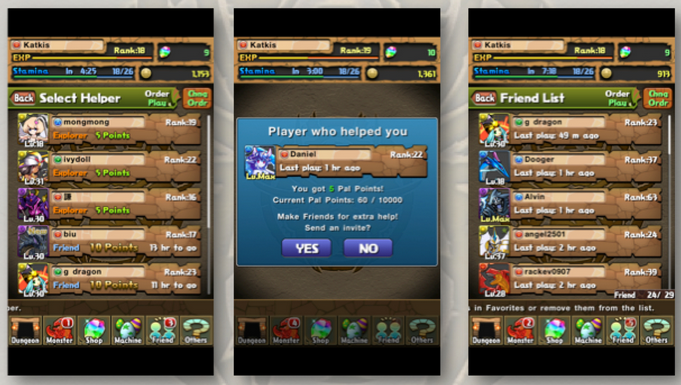
When entering the dungeon, the user must select an assistant. After clearing the dungeon together, they become friends. The more friends you have, the more Pal Points you get, which are spent on buying eggs
So, in a nutshell, the social mechanics of the game increases the level of retention, encouraging as often as possible to return to the game throughout the day. Social mechanics also encourages users to upgrade, because the cooler your monster is, the more likely it is that other users will choose it as an assistant, and the more Pal Points you will have, with which you can purchase more monsters “for pumping”.
8. Special Dungeons (events)
There are several special dungeons open to the public for a limited number of times. Some of them are available only on Monday, others for several hours.
All such dungeons are a serious challenge for players. In any case, if the user wants to properly pump his deck of monsters (which implies not so much growth in level as evolution), he needs to pass them.
The only way to get cool monsters is their evolution, which, as mentioned above, requires sets of fairly rare monsters that are given for passing special dungeons. So it turns out that in order to grow in the game, the user must pass special dungeons, the passage of which requires powerful monsters, high stamina and powerful friends. In other words, special events fit perfectly into the basic mechanics of the project.
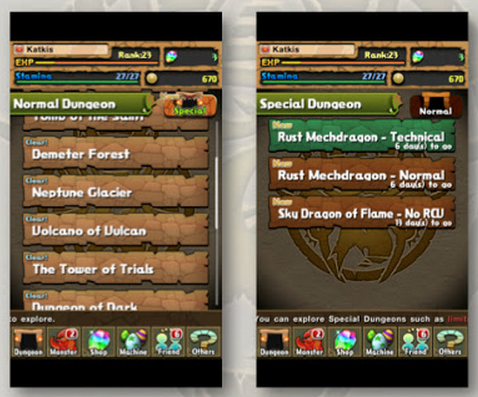
Access to special dungeons is limited in time. They also require more stamina to enter, and it is more difficult to pass them. But only in them there are rare “evolutionary” monsters
Yes, such dungeons are really difficult. Read the description of strategies for their passage.
8+. Do you want to continue? Pay up!
Remember arcade machines? Do you remember how you played Time Cop or Virtual Fighter, how you lost in them? Do you remember how after the defeat, the inscription “Continue?” hung on the screen for 10 seconds? Do you remember that during these seconds it was necessary to throw a coin into the slot machine so as not to start the game from the beginning?
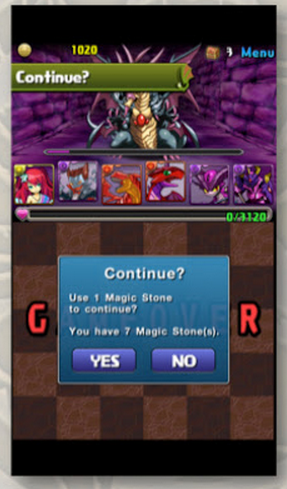
Pay to continue. Simple and very effective!
Puzzle & Dragons has the same mechanics, and it burns!
Cool game, but only in Japan
Puzzle & Dragons has held the first place in the box office top of the Japanese App Store since February. If you look at the American “apple” store, then in it the game did not even get into the box office top 50.

In the American App Store, the game failed to repeat its success
Explaining the relative failure in the States is not so difficult. It’s about the high difficulty of Puzzle & Dragons. Without experience playing other Japanese projects, where evolutionary mechanics are widely used, GungHo’s creation is difficult to understand and, moreover, to enjoy it. On the other hand, Rage of Bahamut did it, Marvel: War of Heroes did it too. Both projects are much more difficult to master, although they have the same general principles.
I think it’s a combination of high complexity, an unsuccessful setting and a modest user acquisition campaign. You will not see a large number of collectible games from Japan and Korea, because they are not close to us. Because of the unfamiliar setting, the game only becomes more difficult. For more experienced users who understand how to play Puzzle & Dragons, a serious drawback is the lack of PvP. In addition, it seems to me that GungHo did not have the task of gaining leadership in the US App Store at any cost, unlike DeNA and GREE, who can buy themselves the first place in the top, even if it leads to losses.
